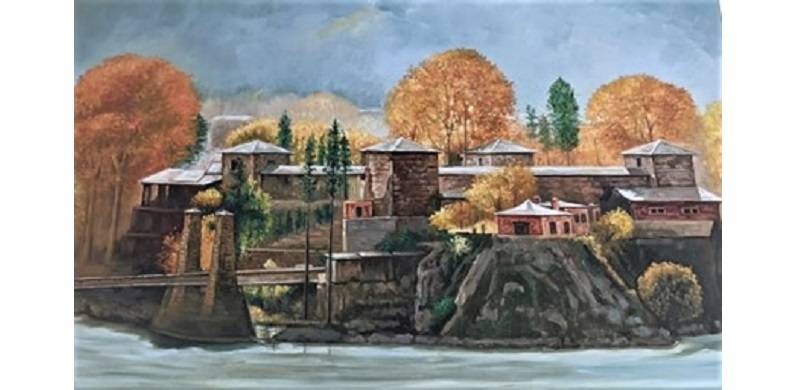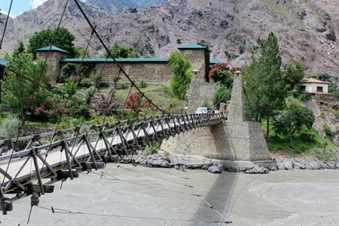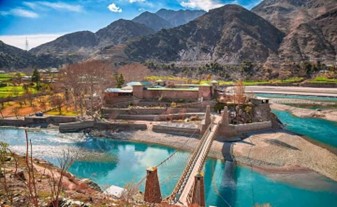
In the lower Chitral region of Pakistan's Chitral Valley, Nagar is a settlement where the Nagar Fort is located. The fort was built by initially built as military fortification by Mehtar Aman-ul-Mulk in 1878 to protect Chitral from any invasion planned either from the Dir side or Afghanistan. Later, due to its location, which is relatively warmer than other areas of Chitral, it was expanded on the orders of the then Mehtar of Chitral, Shuja-ul-Mulk, as a winter retreat for the Mehtar. In 1936, after the demise of the Mehtar, his son Shahzada Ghaziuddin received the estate of Nagar. Shahzada Sirajuddin, the Sarkar of Nagar (1926 -1999), later received possession of Nagar Fort.
Shahzada Sirajuddin was well-liked by people both inside and outside of Chitral. He made significant contributions for the improvement of Nagar. The beautiful lawns and luxuriant plantings found inside the Fort and vicinity are evidence of the Sarkar's intense interest in horticulture. Shahzada Salahuddin, his son, shares this devotion that his father most deeply cherished. The current inhabitants are the fifth generation. The Shahzada family owns most of the land, and the majority of the residents are employed in related fields. The word Noghor, which in the Khowar language, or Chitrali language, signifies fort, gave rise to the name Naghar. In Chitrali, the name is known as Naghar, while in Urdu, it is known as Nagar.
 The Fort features an Inner Gate, an Inner Courtyard, an Outer Court and an Outer Courtyard. There are numerous gardens, and maintenance of them is given much attention. The fort appears stunning when viewed from the nearby road. The Nagar Fort offers a magnificent view of the mountains in the area. Shahzada Sirajuddin, the Sarkar of Nagar (1926–1999), adored flowers and gathered a variety of species. Different fruits, including oranges, cherries, apples and many more, are being planted in a natural fashion. The garden of the fort contains a wide variety of flowers and fruits that were imported from European nations. The Nagar fort is a sizable structure with four sections, each of which has gardens. Tourists may visit the fort if they like, but they must first obtain permission from the Shahzada family, who currently reside there. There is a sizable garden with orchards, flowers, and enormous maple trees that is referred to as a bagh in Urdu. You might compare the garden to the basic, lovely English gardens since it is very natural and simple, which draws tourists. A profusion of roses, daffodils and herbaceous plants diffuse their sweet smell in the air, and the Nagar Bagh is home to gorgeous birds that migrate there throughout the year. Water surrounds the fort on three sides, and the only way to enter is through river side. It is accessible through a suspension bridge and is perched on a ridge. The Nagar suspension bridge was completed in 1944 by the British, built specifically for the fort at that time.
The Fort features an Inner Gate, an Inner Courtyard, an Outer Court and an Outer Courtyard. There are numerous gardens, and maintenance of them is given much attention. The fort appears stunning when viewed from the nearby road. The Nagar Fort offers a magnificent view of the mountains in the area. Shahzada Sirajuddin, the Sarkar of Nagar (1926–1999), adored flowers and gathered a variety of species. Different fruits, including oranges, cherries, apples and many more, are being planted in a natural fashion. The garden of the fort contains a wide variety of flowers and fruits that were imported from European nations. The Nagar fort is a sizable structure with four sections, each of which has gardens. Tourists may visit the fort if they like, but they must first obtain permission from the Shahzada family, who currently reside there. There is a sizable garden with orchards, flowers, and enormous maple trees that is referred to as a bagh in Urdu. You might compare the garden to the basic, lovely English gardens since it is very natural and simple, which draws tourists. A profusion of roses, daffodils and herbaceous plants diffuse their sweet smell in the air, and the Nagar Bagh is home to gorgeous birds that migrate there throughout the year. Water surrounds the fort on three sides, and the only way to enter is through river side. It is accessible through a suspension bridge and is perched on a ridge. The Nagar suspension bridge was completed in 1944 by the British, built specifically for the fort at that time.
The fort has a separate resort for visitors; situated close to the fort and is affixed to its walls. The rooms are pleasant and straightforward. When you sleep in them, you can hear the river's singing, which lulls you to sleep – you might open the window to let in a cool, crisp air. Since 1927, tourists have been visiting Nagar: there is a visitors’ book that details every visitor's history. There are numerous guest books, both modern and old. Robert de Niro is one among many examples of the notable people who visited Nagar and stayed in the fort. You can glimpse a view of the Lowari Top, which features stunning ice caps, from Nagar. The Nagar fort has a garden on its back side that is only for privileged visitors. Visitors who have been there have said that it is exactly like sitting on the Titanic while enjoying a stunning view of the Chitral River. From there, the river's top appears to be right overhead or moving in your direction. The Nagar Fort offers spectacular views of the surrounding mountains.
This site might aid in re-discovering and reiterating the Chitrali principles of respect for mankind, tolerance and peace. Furthermore, cultural legacy is a gift that is passed down from one generation to the next. Because of this, strengthening our identity is served by managing and safeguarding cultural historical assets and teaching the local community about them. Greater focus on cultural heritage may enable us to discover our roots and gain some insight from our past. Without cultural heritage, we would lose our primary means of self-expression and ultimately, our capacity for self-realisation.
And so it is that our shared cultural legacy, which includes these forts, strengthens our feeling of identity as Chitralis. It aids in our children having a better understanding of their parents and grandparents. We might meet individuals who share our ideals or way of thinking thanks to it. It serves as a reminder that we are at home. The tourism component that these heritage sites provide is no less significant.
Shahzada Sirajuddin was well-liked by people both inside and outside of Chitral. He made significant contributions for the improvement of Nagar. The beautiful lawns and luxuriant plantings found inside the Fort and vicinity are evidence of the Sarkar's intense interest in horticulture. Shahzada Salahuddin, his son, shares this devotion that his father most deeply cherished. The current inhabitants are the fifth generation. The Shahzada family owns most of the land, and the majority of the residents are employed in related fields. The word Noghor, which in the Khowar language, or Chitrali language, signifies fort, gave rise to the name Naghar. In Chitrali, the name is known as Naghar, while in Urdu, it is known as Nagar.
 The Fort features an Inner Gate, an Inner Courtyard, an Outer Court and an Outer Courtyard. There are numerous gardens, and maintenance of them is given much attention. The fort appears stunning when viewed from the nearby road. The Nagar Fort offers a magnificent view of the mountains in the area. Shahzada Sirajuddin, the Sarkar of Nagar (1926–1999), adored flowers and gathered a variety of species. Different fruits, including oranges, cherries, apples and many more, are being planted in a natural fashion. The garden of the fort contains a wide variety of flowers and fruits that were imported from European nations. The Nagar fort is a sizable structure with four sections, each of which has gardens. Tourists may visit the fort if they like, but they must first obtain permission from the Shahzada family, who currently reside there. There is a sizable garden with orchards, flowers, and enormous maple trees that is referred to as a bagh in Urdu. You might compare the garden to the basic, lovely English gardens since it is very natural and simple, which draws tourists. A profusion of roses, daffodils and herbaceous plants diffuse their sweet smell in the air, and the Nagar Bagh is home to gorgeous birds that migrate there throughout the year. Water surrounds the fort on three sides, and the only way to enter is through river side. It is accessible through a suspension bridge and is perched on a ridge. The Nagar suspension bridge was completed in 1944 by the British, built specifically for the fort at that time.
The Fort features an Inner Gate, an Inner Courtyard, an Outer Court and an Outer Courtyard. There are numerous gardens, and maintenance of them is given much attention. The fort appears stunning when viewed from the nearby road. The Nagar Fort offers a magnificent view of the mountains in the area. Shahzada Sirajuddin, the Sarkar of Nagar (1926–1999), adored flowers and gathered a variety of species. Different fruits, including oranges, cherries, apples and many more, are being planted in a natural fashion. The garden of the fort contains a wide variety of flowers and fruits that were imported from European nations. The Nagar fort is a sizable structure with four sections, each of which has gardens. Tourists may visit the fort if they like, but they must first obtain permission from the Shahzada family, who currently reside there. There is a sizable garden with orchards, flowers, and enormous maple trees that is referred to as a bagh in Urdu. You might compare the garden to the basic, lovely English gardens since it is very natural and simple, which draws tourists. A profusion of roses, daffodils and herbaceous plants diffuse their sweet smell in the air, and the Nagar Bagh is home to gorgeous birds that migrate there throughout the year. Water surrounds the fort on three sides, and the only way to enter is through river side. It is accessible through a suspension bridge and is perched on a ridge. The Nagar suspension bridge was completed in 1944 by the British, built specifically for the fort at that time.The fort has a separate resort for visitors; situated close to the fort and is affixed to its walls. The rooms are pleasant and straightforward. When you sleep in them, you can hear the river's singing, which lulls you to sleep – you might open the window to let in a cool, crisp air. Since 1927, tourists have been visiting Nagar: there is a visitors’ book that details every visitor's history. There are numerous guest books, both modern and old. Robert de Niro is one among many examples of the notable people who visited Nagar and stayed in the fort. You can glimpse a view of the Lowari Top, which features stunning ice caps, from Nagar. The Nagar fort has a garden on its back side that is only for privileged visitors. Visitors who have been there have said that it is exactly like sitting on the Titanic while enjoying a stunning view of the Chitral River. From there, the river's top appears to be right overhead or moving in your direction. The Nagar Fort offers spectacular views of the surrounding mountains.
This site might aid in re-discovering and reiterating the Chitrali principles of respect for mankind, tolerance and peace. Furthermore, cultural legacy is a gift that is passed down from one generation to the next. Because of this, strengthening our identity is served by managing and safeguarding cultural historical assets and teaching the local community about them. Greater focus on cultural heritage may enable us to discover our roots and gain some insight from our past. Without cultural heritage, we would lose our primary means of self-expression and ultimately, our capacity for self-realisation.

And so it is that our shared cultural legacy, which includes these forts, strengthens our feeling of identity as Chitralis. It aids in our children having a better understanding of their parents and grandparents. We might meet individuals who share our ideals or way of thinking thanks to it. It serves as a reminder that we are at home. The tourism component that these heritage sites provide is no less significant.

